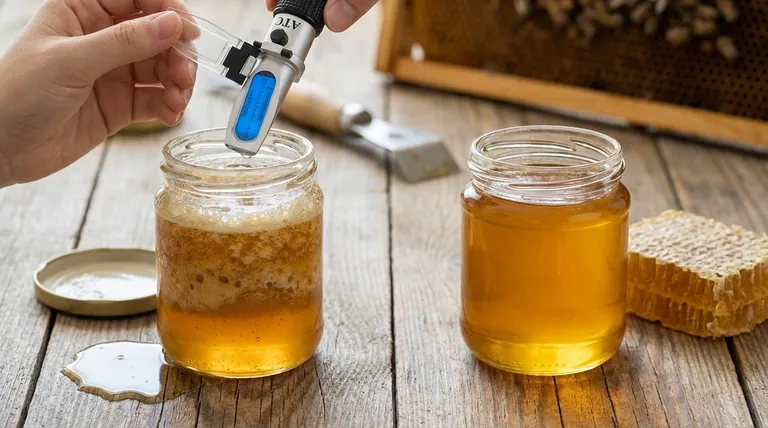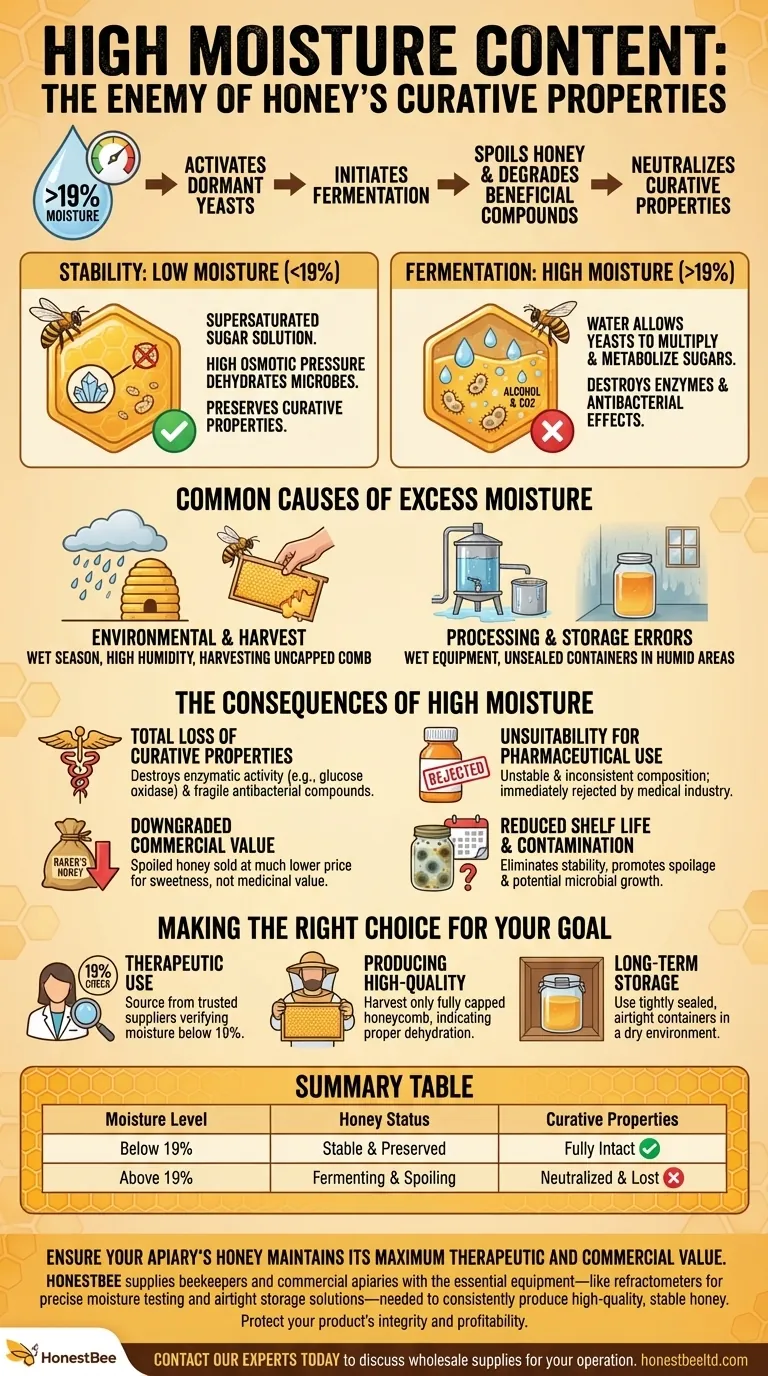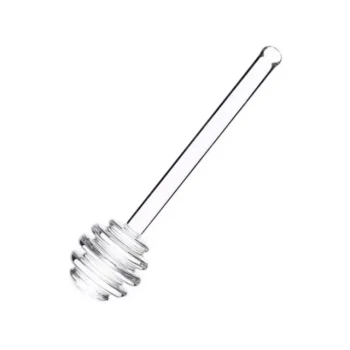High moisture content is the primary factor that neutralizes honey's curative properties. Excess water, typically any level above 19%, activates dormant yeasts that are naturally present in honey. This initiates a process of fermentation, which spoils the honey, degrades its beneficial compounds, and renders it unsuitable for medicinal or pharmaceutical use.
Honey's legendary stability and antibacterial effects are a direct result of its low water content, which creates an environment where microbes cannot survive. High moisture reverses this fundamental characteristic, allowing fermentation to destroy the very properties that make honey a valuable curative agent.

The Mechanism of Spoilage: From Stability to Fermentation
Why Low Moisture Makes Honey Stable
Properly cured honey is a supersaturated sugar solution with very little "free" water available for microorganisms. This creates a high osmotic pressure that effectively dehydrates and kills bacteria and yeast by drawing the water out of their cells. This is the core principle behind honey's natural preservative quality.
The Tipping Point: Activating Dormant Yeasts
Honey naturally contains wild, osmotolerant (sugar-loving) yeasts. In honey with low moisture (under 19%), these yeasts remain dormant and harmless. However, once the moisture content rises, it provides the yeasts with the water they need to become active, multiply, and begin metabolizing the honey's sugars.
The Fermentation Cascade
Once activated, the yeasts consume the glucose and fructose in the honey. This process produces byproducts, primarily alcohol and carbon dioxide. This chemical change alters the honey's flavor, aroma, and composition, effectively spoiling it and degrading the delicate enzymes and compounds responsible for its curative effects.
Common Causes of Excess Moisture
Environmental and Harvest Factors
Honey's moisture content is heavily influenced by its environment. Harvesting during a wet season, in a highly humid climate, or before the bees have had a chance to dehydrate the nectar and cap the honeycomb cells are common reasons for excessively wet honey.
Processing and Storage Errors
Moisture can also be introduced after the harvest. Using wet equipment during the extraction process or storing honey in an unsealed container in a humid environment can allow it to absorb moisture directly from the air, raising its water content over time.
The Consequences of High Moisture
Total Loss of Curative Properties
Fermentation fundamentally changes honey's chemical makeup. This process destroys the enzymatic activity (like glucose oxidase, which produces hydrogen peroxide) and other fragile compounds that give honey its antibacterial and therapeutic qualities.
Unsuitability for Pharmaceutical Use
The pharmaceutical and medical industries rely on honey's stability and predictable composition. Fermented or high-moisture honey is immediately rejected because it is unstable, inconsistent, and lacks the very properties for which it is being used.
Downgraded Commercial Value
Honey that has begun to ferment is considered spoiled and cannot be sold as table-grade honey. At best, it may be downgraded to "baker's honey," where it is used purely for its sweetness and will be heat-treated, commanding a much lower price.
Reduced Shelf Life and Contamination
The stability of low-moisture honey gives it an almost indefinite shelf life. High moisture content eliminates this, promoting the growth of not only yeasts but potentially other microorganisms, leading to rapid spoilage and contamination.
Making the Right Choice for Your Goal
Whether you are producing, purchasing, or using honey, understanding the critical role of moisture content is paramount.
- If your primary focus is therapeutic use: Source honey from trusted suppliers who can verify a moisture content below 19% to ensure its medicinal properties are fully intact.
- If your primary focus is producing high-quality honey: Harvest only fully capped honeycomb, which is the bees' signal that the honey has been dehydrated to a stable moisture level.
- If your primary focus is long-term storage: Always keep honey in a tightly sealed, airtight container in a dry environment to prevent it from absorbing atmospheric moisture.
Ultimately, controlling moisture is the single most important factor in preserving the unique power and stability of honey.
Summary Table:
| Moisture Level | Honey Status | Curative Properties |
|---|---|---|
| Below 19% | Stable & Preserved | Fully Intact |
| Above 19% | Fermenting & Spoiling | Neutralized & Lost |
Ensure your apiary's honey maintains its maximum therapeutic and commercial value.
HONESTBEE supplies beekeepers and commercial apiaries with the essential equipment—like refractometers for precise moisture testing and airtight storage solutions—needed to consistently produce high-quality, stable honey. Protect your product's integrity and profitability.
Contact our experts today to discuss wholesale supplies for your operation.
Visual Guide

Related Products
- Precision Honey Refractometer Instrument for Quality Assessment
- Premium Heat-Resistant Glass Honey Dipper
- Modern Honeycomb Pattern Wooden Honey Dipper for Stirring and Drizzling
- Stainless Steel Honey Press Wax Press with Tank
- Stainless Steel Manual Honey Press with Guard for Pressing Honey and Wax
People Also Ask
- What are the key steps to using a honey refractometer? Ensure Honey Quality & Prevent Fermentation
- What is a honey refractometer and what is its purpose? Ensure Honey Quality and Prevent Spoilage
- How does a honey refractometer work? Ensure Honey Quality & Harvest Readiness
- Why is a honey refractometer considered essential for commercial beekeepers? Ensure Honey Quality and Profitability
- Why is a honey refractometer important for beekeepers? Ensure Quality and Prevent Fermentation



















